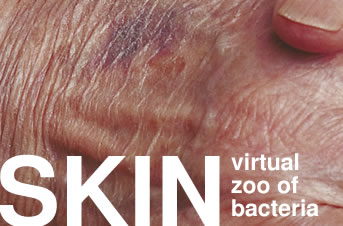Feb 7 2007
According to a new study, the largest organ in our body, the skin, is home to a virtual zoo of bacteria some of which are have never been seen before.
Scientists at the New York University School of Medicine say they found 182 species of bacteria in skin samples taken from study participants.
Eight percent of the bacteria found were unknown species that had never seen before.
This study of the bacterial populations in the human skin, is the first to identify the composition of bacterial populations on the skin using a powerful molecular method.
The researchers found that not only were the bacteria more diverse than previously estimated, but some of them had not been found before.
Dr. Martin J. Blaser, Frederick King Professor and Chair of the Department of Medicine and Professor of Microbiology at NYU School of Medicine, one of the authors of the study, says the skin is home to a "virtual zoo of bacteria".

The team analyzed the bacteria on the forearms of six healthy subjects, three men and three women.
None had been taking antibiotics for up to one month prior to the test.
The researchers took swabs from the inner right and left forearms, halfway between the wrist and the elbow, an area not subjected to frequent washing, because they wanted to be able to compare two similar parts of the body.
As they also wanted to study change over time, they took more swabs from four of the individuals 8 to 10 months after the first test.
Dr. Blaser says until now the skin has been an unknown world that he and his colleagues have set out to understand rather like explorers.
The research, which took more than three years to complete, was led by Dr. Zhan Gao, a senior research scientist and it has revealed that some of the bacteria on the skin appear to be more or less permanent residents while others are transient residents.
The research constitutes part of an attempt to study human microbial ecology; Dr. Blaser's laboratory has previously examined the bacterial population in the stomach and the esophagus.
Blaser says everyone lives with bacteria all their lives and many of the bacteria in the human body are still unknown.
Dr. Blaser says as the ultimate aim is to compare disease and health, keeping bacterial populations in our body stable may be part of staying healthy.
He says the most common cells in the body are microbial which outnumber other cells by a 10 to 1 ratio, and the body has microbes native to the body, including the skin, and these populations change according to how we live.
Over half (54.4%) of the bacteria identified are considered more or less permanent residents in human skin, but the volunteers were markedly different in the overall composition of the bacterial populations on their skin and only four species of bacteria were common.
Dr. Gao says many things affecting the skin affect bacteria, such as the weather, exposure to light, and cosmetics use.
According to the study almost three-quarters (71.4%) of the total number of bacterial species were unique to individual subjects, which suggests that the skin surface is highly diversified in terms of the bacteria it harbors.
Of the bacteria, three species were only found in the male subjects which suggests say the researchers that women and men may harbor some different bacterial species on their skin.
In each individual, the bacterial populations varied over time while revealing a core set of bacteria for each individual.
Dr. Gao says in each participant the predominant bacteria do not change much, but the more transient bacteria do change over time and skin condition can change markedly due to a variety of factors such as climate, diet, personal hygiene, and disease.
But skin, she says is never devoid of bacteria, particularly its more permanent residents, which is not bad news, as without good bacteria, the body could not survive.
The research team now plan to look at diseased skin in order to see if the microbes are different to those in normal skin.
This study is published February 5, 2007, in the online edition of the Proceedings of the National Academy of Sciences.